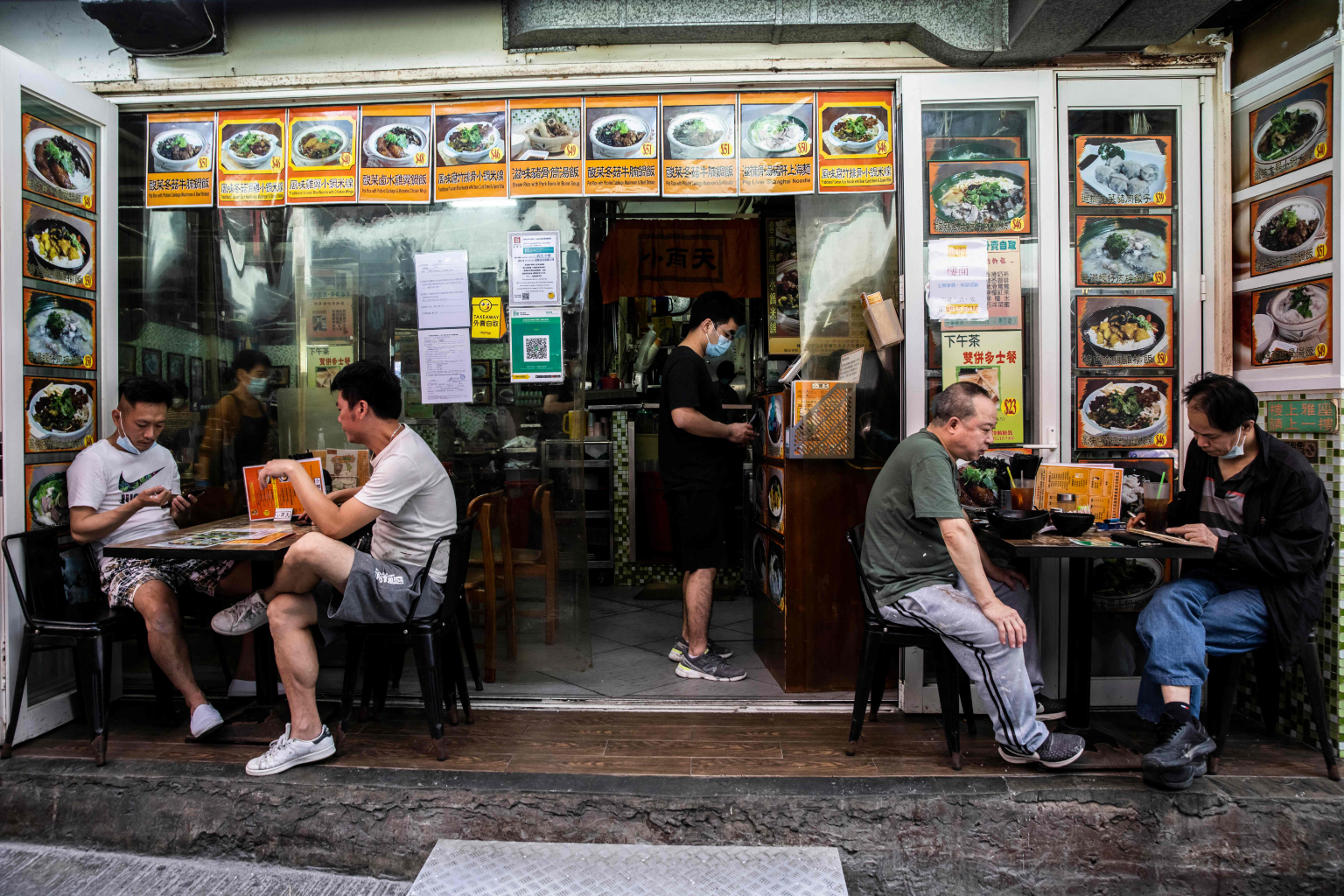Hong Kong backpedals on home quarantine for those with Covid-19 sub-variants
Sign up now: Get insights on Asia's fast-moving developments

Customers at a restaurant in Hong Kong on April 14, 2022.
PHOTO: AFP
Follow topic:
HONG KONG (BLOOMBERG) - Hong Kong is reviving one of its toughest Covid-19-zero measures, forcing patients with even mild infections caused by new Omicron sub-variants and their close contacts into centralised quarantine to tame any spread.
People infected with sub-strains including BA.2.12.1 who are not severely sick, as well as their close contacts, will be sent to government facilities like Penny's Bay as officials try to ring-fence their spread.
The rule has been enforced for all 34 people with the newest forms of the virus in the city thus far, officials said, including at least two families linked to a cluster at a Canadian school who argued that their living situations were suitable for home isolation.
Both families said they requested to quarantine at home because they had their own kitchen and bathrooms - a standard requirement for approval - but the health authorities told them they would be sent to an isolation facility because the cluster involved a new sub-variant, according to the families.
"We have to take a more stringent approach to deal with this Omicron sub-lineage," Dr Edwin Tsui, controller of the Centre for Health Protection, said at a briefing on Wednesday (June 1), confirming the families' accounts.
The Omicron sub-variants that Hong Kong is monitoring, including BA.4 and BA.5, may have higher transmissibility and higher immune escape, he said.
It is a reversal of a practice that has allowed most mildly ill patients and their close contacts to stay at home - a measure that has been in place since February when an Omicron wave overwhelmed the city's specially constructed Covid-19 isolation facilities.
The return of mandatory quarantine in some cases has the potential to drive even more people from the Asian financial hub, where curbs like seven-day hotel quarantine for incoming travellers still exist, though the rules are not as strict as in mainland China.
Harsh virus measures and an outbreak that spiralled into the world's deadliest sparked an exodus of people from Hong Kong in recent months, chiefly to the rival hub of Singapore. The arrival of new sub-variants has not caused a substantial spike in daily cases, which have dropped from a peak in March to just hundreds per day.
Precautionary measure
The reversion to centralised quarantine runs counter to recent commentary from Hong Kong health experts that the public should not be too worried about the BA.2.12.1 sub-variant as it is quite similar to BA.2, which spread rampantly through the city earlier this year. More than 87 per cent of Hong Kong residents have had two vaccine doses, giving a good level of protection.
The government said in a statement late on Wednesday that new sub-variant cases were being isolated in government facilities as a precautionary measure, and the move does not signify a change in its overall quarantine and isolation policy. The new sub-variant came to Hong Kong through an infected traveller and subsequently spread through the community, with clusters at a McDonald's restaurant and the Canadian DSC International School.
The DSC International School cluster has risen to eight cases, according to health officials.
The school said in a statement that quarantine arrangements had been made by the Centre for Health Protection. The school had sanitised the campus several times, and offered online learning and counselling to students in quarantine.
A nine-year-old Covid-19-positive pupil was admitted to hospital on May 28 after experiencing fever, while her mother, father and older brother were taken to a community isolation facility in Sai Kung the same day, said Ms Junko Nishida, the girl's mum. Ms Nishida works for Bloomberg, the parent company of Bloomberg News.
While initially separated from her daughter, Ms Nishida was approved to stay with her in the hospital from Monday night. Her husband subsequently tested positive for Covid-19 and was admitted to the same hospital, and their 12-year-old son has also been able to join them. The family members have not been given any instruction as to when they will be discharged and whether, or where, they may have to serve subsequent quarantine.
Another parent, who asked not to be identified for privacy reasons, said his two daughters tested positive via rapid antigen tests on May 28 and were told on Sunday that the family members would be moved to Penny's Bay due to the involvement of the sub-variant.
They were relocated to the facility on Monday, where they found the accommodation to be damp and with cockroaches, the parent said. They will be allowed to leave Penny's Bay if their polymerase chain reaction tests on days six and seven of isolation come back negative.
The family members are considering relocating back to their home country, the parent said, expressing disappointment with the changing rules and refusal to allow them to quarantine at home.
Even as the authorities shifted to allowing home quarantine during the last outbreak, the spectre of central isolation camps has lingered. Hong Kong rushed to expand facilities and took over hotels as its so-called fifth wave surged, taking citywide capacity to a peak of about 70,000 places. While some centres have stopped operating, the authorities have kept a number of facilities on standby for future use.
The potential revival of strict containment measures comes as the city anticipates the installation of a new chief executive, Mr John Lee, on July 1. Outgoing leader Carrie Lam has overseen an easing of pandemic curbs since April as daily cases ebbed, but has said there will not be any further significant moves in her remaining tenure.
Mr Lee, who oversaw the city's isolation camps in his former role as chief secretary, has given little indication as to whether he plans to shift Hong Kong towards living with the virus like much of the rest of the world, or closer to Beijing's hardline posture.

